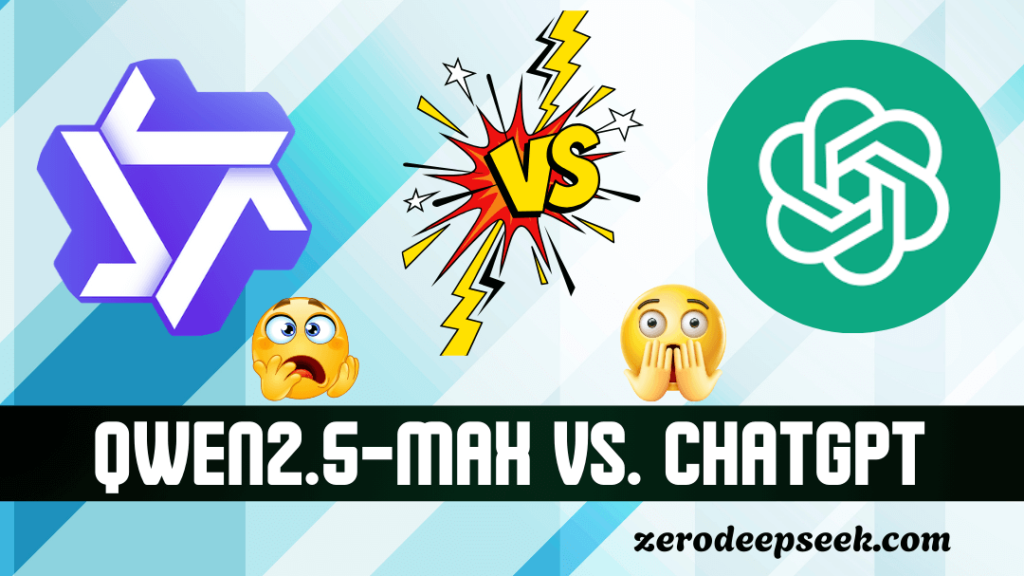Artificial Intelligence has transformed the way businesses, developers, and individuals interact with technology. Among the leading AI-powered large language models (LLMs), Qwen2.5-Max, developed by Alibaba Cloud, and ChatGPT, built by OpenAI, stand out as powerful contenders. But how do these models compare in terms of features, accuracy, usability, and industry applications?
In this in-depth analysis, we’ll explore their capabilities, strengths, limitations, and best use cases to help you determine the best AI model for your specific needs.
Read also Qwen2.5-Max vs Deepseek: A Detailed AI Model Comparison

What is Qwen2.5-Max?
Qwen2.5-Max is an advanced AI language model developed by Alibaba Cloud as part of the Qwen series. Designed for high-level reasoning, text generation, and business applications, it boasts superior multi-turn conversation abilities, making it a powerful tool for professionals in finance, healthcare, and research.
Key Features of Qwen2.5-Max:
✅ Optimized for enterprise use (legal, healthcare, finance)
✅ Advanced NLP for in-depth reasoning and decision-making
✅ Larger context window for enhanced memory retention
✅ Fine-tuned for multilingual processing
What is ChatGPT?
ChatGPT is OpenAI’s flagship AI chatbot, designed for general-purpose use across business, education, and creative applications. Available in multiple versions (including GPT-4 and GPT-3.5), ChatGPT excels in conversational AI, content creation, and problem-solving.
Key Features of ChatGPT:
✅ Versatile AI suitable for casual users, businesses, and developers
✅ Creative content generation (blog posts, marketing copy, coding assistance)
✅ Highly interactive and user-friendly chatbot experience
✅ Integrates with OpenAI API for business automation
Qwen2.5-Max vs. ChatGPT: A Side-by-Side Comparison
Technical Architecture and Training
| Feature | Qwen2.5-Max | ChatGPT (GPT-4) |
|---|---|---|
| Developer | Alibaba Cloud | OpenAI |
| Model Size | Large-scale (proprietary) | Multi-billion parameters |
| Training Data | Multilingual, diverse datasets | Books, web content, coding data |
| Context Window | Extended for business applications | Large but variable across versions |
| API Integration | Enterprise-grade | OpenAI API for various applications |
Key Takeaway: While Qwen2.5-Max is optimized for high-precision enterprise tasks, ChatGPT is designed to be a versatile, user-friendly AI for various applications.
Performance and Accuracy: Which Model Excels?
Natural Language Understanding and Generation
- Qwen2.5-Max: Stronger in logical reasoning and professional writing, making it ideal for industry applications like finance, law, and medical research.
- ChatGPT: Excels in conversational AI, storytelling, and informal writing, making it better for customer support, marketing, and creative tasks.
Read also How Developers Can Use DeepSeek For Coding And Debugging
Processing Speed and Response Time
| Feature | Qwen2.5-Max | ChatGPT (GPT-4) |
| Response Speed | Slightly slower due to deep reasoning | Optimized for fast, interactive responses |
| Processing Power | High for complex problem-solving | Well-balanced for general user needs |
Key Takeaway: If you need AI for quick and engaging conversations, ChatGPT is superior. However, for in-depth analysis and enterprise applications, Qwen2.5-Max is a better choice.
Best Use Cases: When to Choose Qwen2.5-Max vs. ChatGPT
When to Choose Qwen2.5-Max
✅ Business & Enterprise Solutions: Suitable for legal analysis, healthcare data interpretation, and financial forecasting.
✅ Professional Documentation: Excels in technical writing, research papers, and detailed reports.
✅ Multilingual Processing: Strong for global enterprises requiring accurate translations and language support.
✅ Advanced AI Reasoning: Best for multi-step problem-solving and strategic decision-making.
When to Choose ChatGPT
✅ Content Creation: Ideal for writing blog posts, marketing copy, social media content, and storytelling.
✅ Coding Assistance: Provides debugging help, code generation, and AI-powered programming support.
✅ Conversational AI: Best for customer support, chatbot automation, and general interactive engagement.
✅ Casual and Business Use: Perfect for everyday tasks, brainstorming, and educational tutoring.
Key Takeaway: Qwen2.5-Max is best suited for corporate and professional use, while ChatGPT is more adaptable for general users, businesses, and creative tasks.
Pricing and Accessibility: Which Model Offers Better Value?
| Factor | Qwen2.5-Max | ChatGPT (GPT-4) |
| Cost | Enterprise-tier pricing | Freemium model with paid pro plans |
| API Access | Limited enterprise access | Available via OpenAI API for businesses |
| Customization | High for specialized industries | Flexible for general applications |
Key Takeaway: Qwen2.5-Max targets enterprise clients with higher pricing, while ChatGPT is more accessible with flexible pricing for individuals and businesses.
Read also DeepSeek Features And Benefits
Final Verdict
Choose Qwen2.5-Max if:
✅ You need AI for high-precision tasks like finance, law, or research.
✅ You work with multilingual data and require professional-grade processing.
✅ You require advanced problem-solving capabilities for enterprise use.
Choose ChatGPT if:
✅ You want an AI optimized for content creation, coding, and casual conversations.
✅ You need a budget-friendly freemium model with accessible API options.
✅ You prefer an AI chatbot that is interactive and user-friendly.
Both models are highly capable, but they serve different audiences. Qwen2.5-Max is ideal for corporate applications, while ChatGPT is a well-rounded AI assistant for everyday use.
Read also How To Use DeepSeek For Business Growth
Conclusion
The AI landscape is rapidly evolving, and Qwen2.5-Max and ChatGPT are leading the way in different sectors. Whether you need an enterprise AI solution or an interactive chatbot, both models offer cutting-edge technology that can revolutionize the way you work and interact with AI.
As AI continues to improve, future versions of Qwen and ChatGPT will push the boundaries of language understanding, making them even more powerful in their respective domains.
🚀 Which AI model do you prefer? Let us know in the comments!


